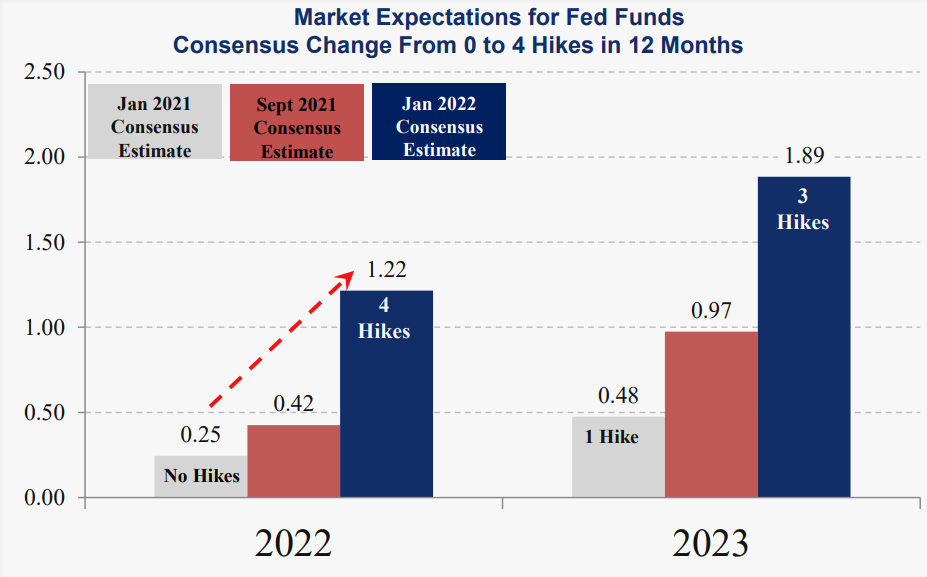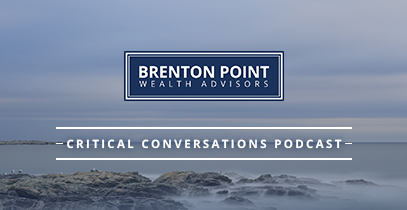Fed Regime Shift
Investing Environment Review and Outlook – Volume 56
Fed Regime Shift
Last month we discussed the developing Fed Pivot from dovish to hawkish beginning with Powell’s comments in November. As of January 1, conditions were positive for U.S. equities since, in prior cases, the S&P 500 rallied in the three months prior to initial hikes, particularly when the economy was strong. In retrospect, the unprecedented magnitude of inflation and the unprecedented Fed advance communication of intentions changed the dynamics this year.
Financial news and commentary is distracting as usual, filled with predictions of the number of Fed hikes ahead. Understanding the implications for asset prices when the Fed hikes rates, and particularly in the context of high inflation and valuation is this month’s focus. We also discuss the shift in investor positioning.
Please note we cut the U.S. Equity rating to a cautious 2. Foreign-developed and emerging markets remain a bullish 5 rating. Long Term bonds remain a cautious 1 rating. Commodities remain a neutral 3 rating and gold remains a bullish 5 rating.
Don’t Fight the Fed and Inflation Together
Historical S&P 500 returns when the Fed was hiking rates offer no reason for panic, averaging 7.7% since 1928 vs. the norm of 10.4%. In addition, the 6 months after initial hikes were even better at 13.9%. The difference this year is much higher inflation than usual at the initial hike. Returns were much worse at -3.7% when the Fed was hiking while inflation was up and rising as it is now. The most recent case in late 2005 was benign since inflation crossed above 4% but quickly reversed lower. Expected equity returns shift positive when inflation turns down, even when the Fed is hiking, and that was true in 2005. Falling inflation and still above 4% is good at 11.2% return, but inflation falling and below 4% is even better at 16.6%.
The most comparable cases when the Fed was hiking with inflation were 1987, 1973 and 1969, all involving S&P 500 bear markets. This doesn’t mean a bear market today, but it is certainly a possibility we are considering. Prior to 1969, the 1950 Korean War inflation spike was the exception that proves the rule. Inflation spiked to 9% over 5 months but then quickly reversed back to 2% over 7 months, with no reaction from the Fed or the S&P 500.


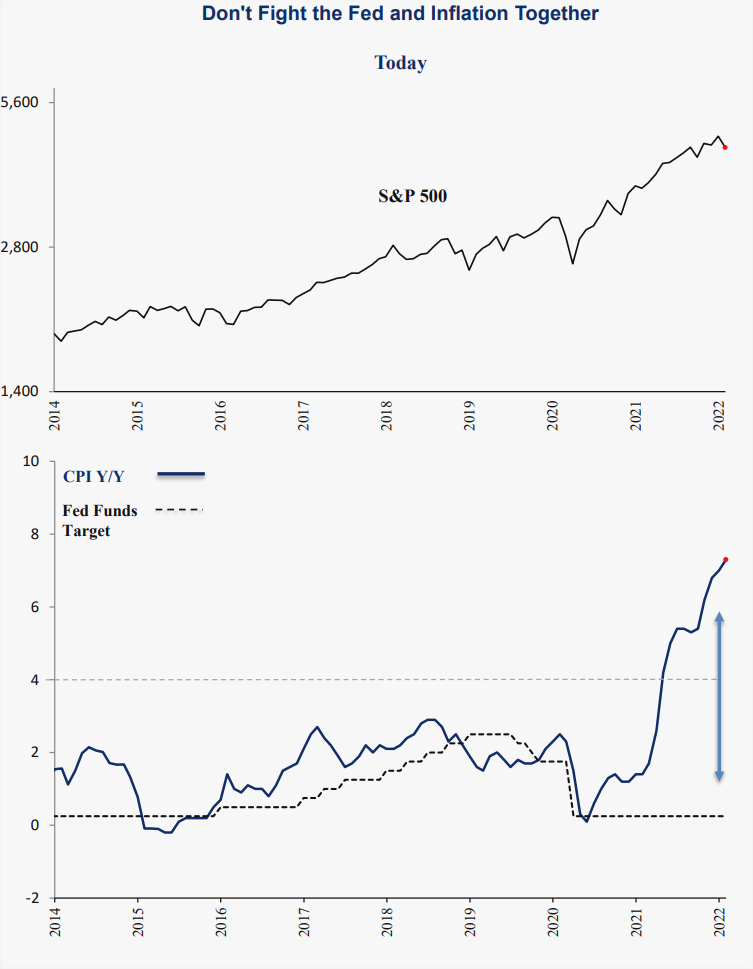
No Break for the Fed in Sight Yet
Given the importance of the inflation level and trend for S&P 500 returns in the new regime when the Fed is hiking rates, we are watching it very carefully from all angles. Despite the break in some supply chain indicators like delivery times, overall inflation outlook indicators were unchanged at an elevated 76 in January, and energy prices continued higher into February. In addition, we will not see low comps for two months until April when the March CPI numbers are released. The take away: although 3-5% inflation ahead is plausible, for now there is no break for the Fed in sight yet.
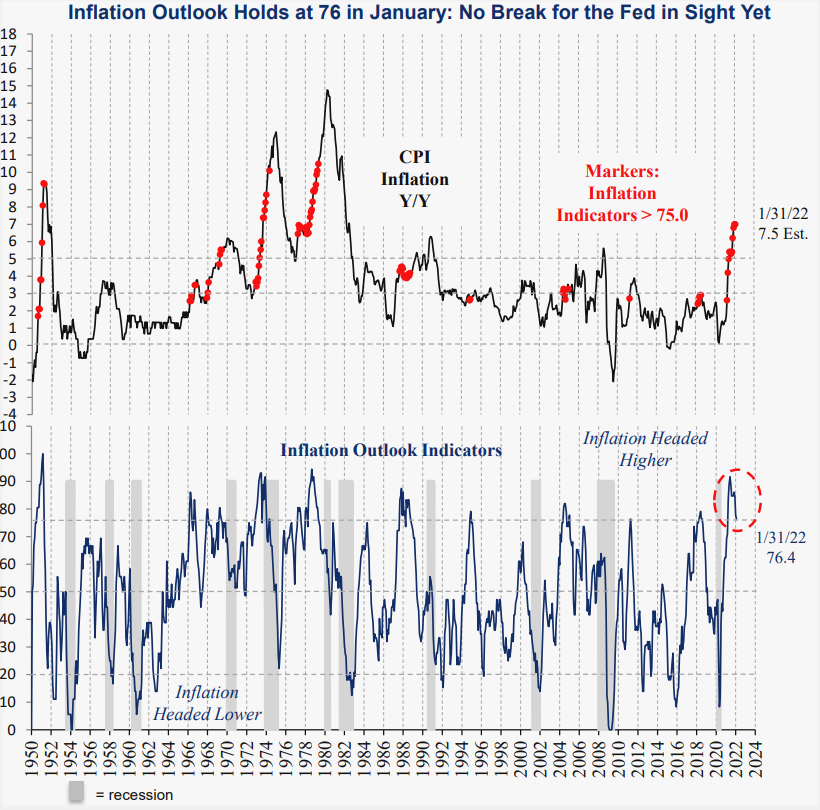
Valuation Risk for Equities
The S&P 500 P/E today is 23.5, in the 93rd percentile of readings since 1910. Certainly “high” by historical standards but impossible to say “overvalued” except in retrospect. Historical comparisons are never entirely accurate since today’s higher weight in growth stocks skews the index P/E to the upside. In other periods like 1982, cyclical stocks with lower P/Es had a bigger weight in the index, skewing the index P/E to the downside.
Despite the measurement issues, a look at historical cases shows high valuation in today’s high inflation context adds an additional downside risk for equities. Years like 1987, 1969, 1973, and 1946 saw high valuation combined with inflation and Fed interest rate hikes, and were all followed by bear markets. The 2000 peak had the highest P/E and was accompanied by the Fed hiking rates but no inflation above 4%. A bear market followed nonetheless. Compare those cases to 1979 when inflation rose from 9% to 13% and the Fed hiked the Fed Funds target from 10% to 15.5%, yet the S&P 500 was up 12% that year. After a decade of bear markets, the S&P 500 P/E began 1979 at 8.2x, in just the 7th percentile of historical readings and low by any standard. The low valuation offered downside protection to an otherwise hostile macro environment.
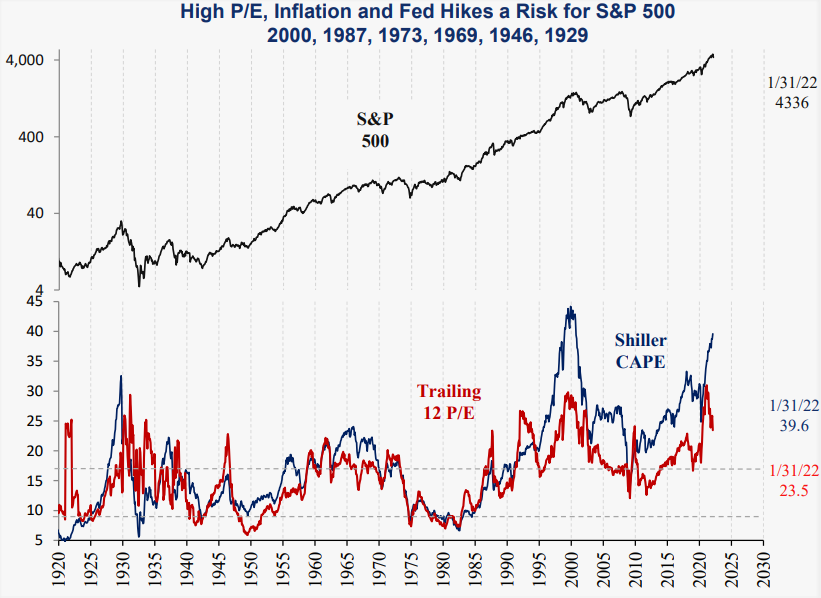
Investors are Nervous and Short
Higher equity volatility this year combined with inflation surprises, Fed hike speculation, and the Ukraine invasion headlines have caused investors to cut back equity exposure to the lowest since the March 2020 COVID crash low. Although long-term expected returns for the S&P 500 are lower as a result of the Fed regime shift to hiking rates, this extreme in positioning shows a lot of bad news is expected and makes a positive surprise and equity upside more likely in the short term.

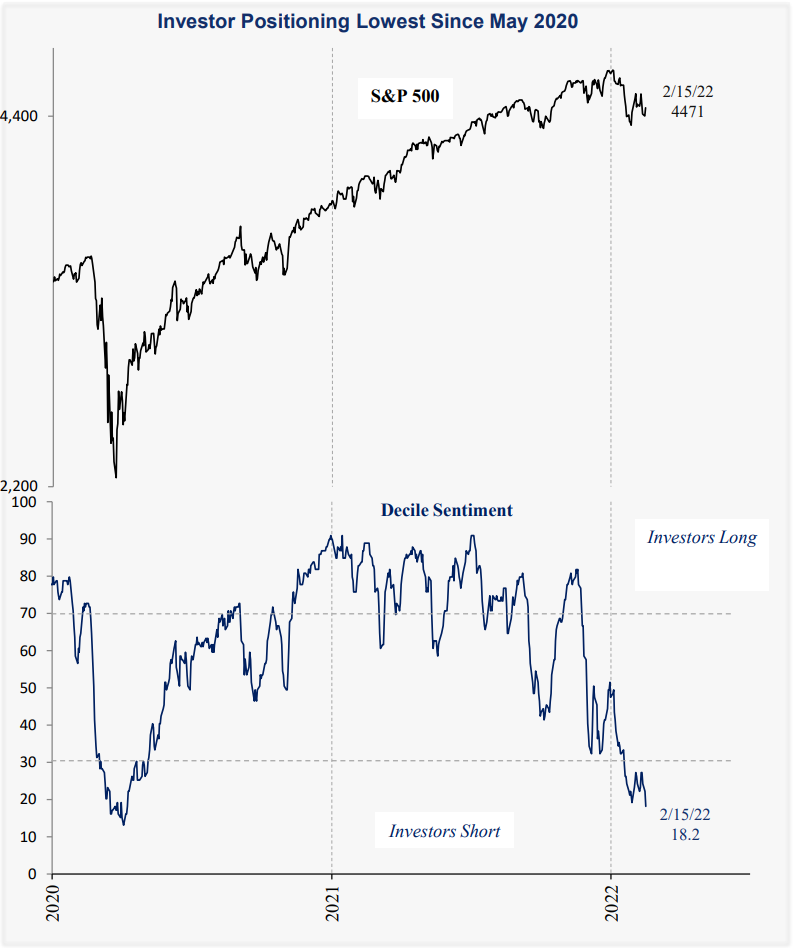
Fed Regime Shift: Bullish for Gold
Gold rates a maximum bullish 5 for many reasons, primarily as a long bond replacement to reduce portfolio volatility through its low correlation with equity returns. Last year was a good example, with the S&P 500 up 28% and gold down 4%. The same holds true this year with the S&P 500 down 7% and gold up 2%. More importantly, the regime shift this month to the Fed hiking rates is bullish for gold. Since 1975, gold returned 6x the norm at 31.2% annualized when the Fed was hiking rates while T-Bill yields were below the inflation rate. T-Bill yields below the inflation rate means cash balances are effectively depreciating at 7% a year, a catalyst for investors to seek alternatives. There were three periods historically when this was true, and gold rallied in all three. The first was from 1977 to 1980 when gold rallied from $130 to the peak of $850 as the Fed tried to slow inflation by hiking rates. Other periods were 2004 to 2006 and from 2015 to 2018. As last year demonstrated, gold is not always an inflation hedge as people assume, but with the Fed hiking rates and inflation destroying the purchasing power of cash, a significant exposure to gold is a rational alternative for any portfolio.
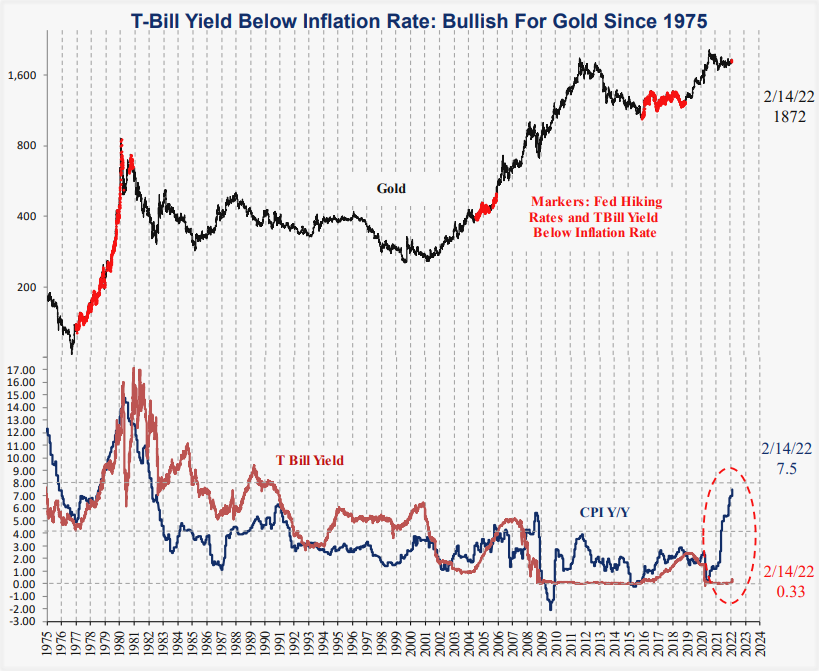
Summary
This month we discussed the implications of the Fed hiking rates, one of the most significant points of any economic cycle, and why it is negative for U.S. equities. We cut our U.S. equity rating from a bullish 5 to a cautious 2 since the forward expected return for the S&P 500 is dramatically lower. Our inflation outlook model remains at 76, indicating pressure on the Fed will persist. Due to the equity volatility, inflation, and growing Fed hike expectations, investor positioning is now the lowest since the March 2020 COVID crash bottom. This investor positioning makes a positive surprise and equity upside more likely in the short term. Gold should be one of the primary beneficiaries of this stage of the cycle and remains the best cash alternative for any portfolio. We will continue testing conditions and will update you as they change. Thank you for your support and please contact us with any questions.
IMPORTANT DISCLOSURES
This review and outlook report (this “Report”) is for informational, illustration and discussion purposes only and is not intended to be, nor should it be construed as, financial, legal, tax or investment advice, of Brenton Point Wealth Advisors LLC or any of its affiliates (“Brenton Point”). This Report does not take into account the investment objectives, financial situation, restrictions, particular needs or financial, legal or tax situation of any particular person and should not be viewed as addressing any recipient’s particular investment needs. Recipients should consider the information contained in this Report as only a single factor in making an investment decision and should not rely solely on investment recommendations contained herein, if any, as a substitution for the exercise of independent judgment of the merits and risks of investments.
This material is based upon information obtained from various sources that Brenton Point believes to be reliable, but Brenton Point makes no representation or warranty with respect to the accuracy or completeness of such information. Views expressed herein are current only as of the date indicated and are subject to change without notice.
This Report contains certain forward looking statements opinions, estimates, projections, assessments and other views (collectively “Statements”). These Statements are subject to a number of assumptions, risks and uncertainties which may cause actual results, performance or achievements to be materially different from future results, performance or achievements expressed or implied by these forward looking statements and projections. Brenton Point makes no representations as to the reasonableness of such assumptions or the likelihood that such assumptions will coincide with actual events and this information should not be relied upon for that purpose. Changes in such assumptions could produce materially different results. Past performance is not a guarantee or indication of future results, and no representation or warranty, express or implied, is made regarding future performance of any financial instrument mentioned in this Report.
Any benchmark shown herein is shown for illustrative purposes only. No index benchmark is available for direct investment. It may not be possible to replicate the returns of any index, as the index may not include any trading commissions and costs or fees, may assume the reinvestment of income, and may have investment objectives, use trading strategies, or have other materials characteristics, such as credit exposure or volatility, that do not make it suitable for a particular person. This is not an offer or solicitation for the purchase or sale of any security, investment, or other product and should not be construed as such. References to specific financial instruments and to certain indices are for illustrative purposes only and provided for the purpose of making general market data available as a point of reference only; they are not intended to be, and should not be interpreted as recommendations to purchase or sell such securities. Investing in securities and other financial products entails certain risks, including the possible loss of the entire principal amount invested, as the value of investment can go down as well as up. You should obtain advice from your tax, financial, legal, and other advisors and only make investment decisions on the basis of your own objectives, experience, and resources.
Brenton Point accepts no liability for any loss (whether direct, indirect or consequential) occasioned to any person acting or refraining from action as a result of any material contained in or derived from this Report, except to the extent (but only to the extent) that such liability may not be waived, modified or limited under applicable law.
This Report may provide addresses of, or contain hyperlinks to, Internet websites. Brenton Point has not reviewed the linked Internet website of any third party and takes no responsibility for the contents thereof. Each such address or hyperlink is provided solely for your convenience and information, and the content of linked third party websites is not in any way incorporated herein. Recipients who choose to access such third-party websites or follow such hyperlinks do so at their own risk.
All marks referenced herein are the property of their respective owners. This Report is licensed for non-commercial use only, and may not be reproduced, distributed, forwarded, posted, published, transmitted, uploaded or otherwise made available to others for commercial purposes, including to individuals within an institution, without written authorization from Brenton Point.
Source of data and performance statistics: Bloomberg L.P. and Factset Research Systems Inc.
©Brenton Point Wealth Advisors LLC 2022

Michael Schaus
Director of Market Research
Michael Schaus is the Director of Market Research for Brenton Point Wealth Advisors and Zweig-DiMenna. Since joining Zweig-DiMenna in 1992, his focus has been on macroeconomic research, the analysis of…
READ MORERead Next:
Sign up!
Sign up for our monthly newsletter and get the lastest news and research from our esteemed advisors here at Brenton point. Right into your inbox!


 Client Login
Client Login

